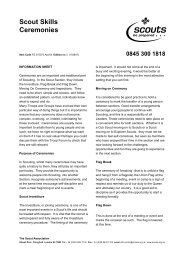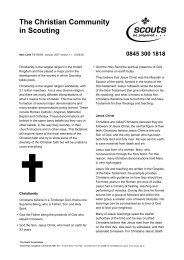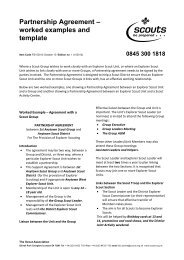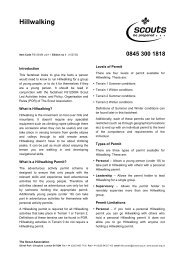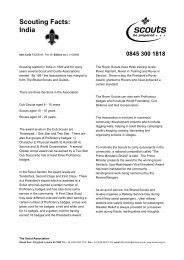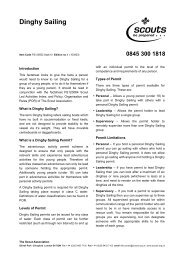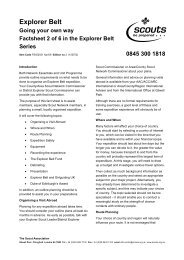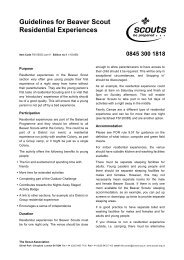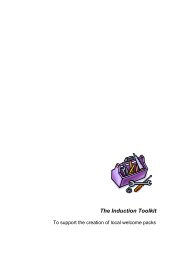Create successful ePaper yourself
Turn your PDF publications into a flip-book with our unique Google optimized e-Paper software.
Item Code FS315080 January 2013© 2013 The <strong>Scout</strong> Association Registered Charity number 306101/SC038437lashingsESSENTIALS<strong>Lashings</strong> are used to join together poles or spars to enablethe construction of objects and structures. In <strong>Scout</strong>ing thisactivity is called pioneering. Common pioneering projectsinclude gateways, bridges and platforms, or smaller campitems such as washstands, chairs, benches and tables. Seethe factsheet on pioneering for more information.Simple lashingsSQUARE LASHINGA square lashing is the most widely used lashing for securingone spar to another when they cross at an angle. It isparticularly used to stop spars sliding over each other.123456Square lashingSquare lashingscouts.org.uk/sac ■ sac@scouts.org.uk ■ 0845 300 2549
DIAGONAL LASHINGA diagonal lashing is used to pull two spars together andprevent them from springing apart, for example, at thecross-brace of a framework.1234SHEER LASHINGThere are two types of sheer lashing. The first is used to jointogether two spars to make a longer length, for example,when making a flagpole. The second type is used to createsheer legs, where the spars are lashed together at one endand opened to form an inverted V-shaped support.Diagonal lashing1234Diagonal lashingShear legs2facebook.com/<strong>Scout</strong>ActivityCentres ■ twitter.com/<strong>Scout</strong>Centres ■ youtube.com/<strong>Scout</strong>ActivityCentres
FIGURE OF EIGHT LASHINGThe figure of eight lashing is also known as the round ortripod lashing. It is used to bring together three spars toform a tripod or gyn.1 2 3 4 5GOOD PRACTICE■ Know your knots before attempting to learn lashings,particularly the clove hitch and the timber hitch, whichare essential elements of a lashing. The clove hitch is usedto secure a rope to a spar, as when beginning a lashing. Itis far more secure than a single half hitch. The timberhitch is used to secure the end of a rope to a spar.■ The key to making secure square and diagonal Figure of lashings eight Figure of eightis to keep them tight and tidy, particularly when frapping.This is when the lashing is passed round one spar andthen completely round between the spars, over andunder at least three or four times, to draw thewhole joint firmly together. It requires tight work, andis best done in pairs, with one <strong>Scout</strong> pullingFigure of hard Figure eight on of the eight end of the lashing while their partner ensuresthe turns at each corner are as tight as possible. However,ensure that lashings used to make sheer legs and tripodshave sufficient play to permit the spars to open out toform a solid base.■ When finishing a lashing with a hitch, make sure itcannot slip round the spar and loosen the lashing.■ Spars and pioneering poles will last much longer if theyare stripped of bark before use. Try to source spruce,larch or ash, and avoid brittle woods like willowand poplar.■ Use good quality rope such as 8 or 10mm diameter sisalfor lashings that will take a strain, though thinner sisalcan be used for small pioneering projects.■ If learning how to tie lashings for the first time, usecardboard tubes rather than wooden spars. Tubes aresmooth and of a constant diameter, making them easyto handle.■ Blocks and hooks will be needed for more advancedpioneering projects such as aerial runways, hoistsand swings.SAFETY Figure of GUIDELINESeight■ Ensure that <strong>Scout</strong>s can tie lashings confidently andsecurely before undertaking pioneering projects.■ Run small scale pioneering projects before progressing tolarge scale outdoor projects.■ Always carry out a risk assessment before undertakingany pioneering activities.■ Ensure that pioneering structures are safe and properlyanchored before allowing anyone to use them.FIND OUT MOREThe Outdoor Adventure Manual (Haynes, 2013) and TheComplete Guide to <strong>Scout</strong>ing <strong>Skills</strong> (Doubleday, 2010) areuseful introductions to lashings. Many other publicationson pioneering and lashings are available, which introduceother types of lashings and offer extra project ideas.Former Gilwell Park Camp Chief John Thurman wrote anumber of classic pioneering guides including PioneeringProjects, Fun with Ropes and Spars, and ProgressivePioneering.Discovery Channel, sponsors of the <strong>Scout</strong> PioneerActivity Badge, has produced an activity pack for <strong>Scout</strong>swith accompanying notes for leaders. Find out more atscouts.org.uk/discovery3 scouts.org.uk/sac ■ sac@scouts.org.uk ■ 0845 300 2549



